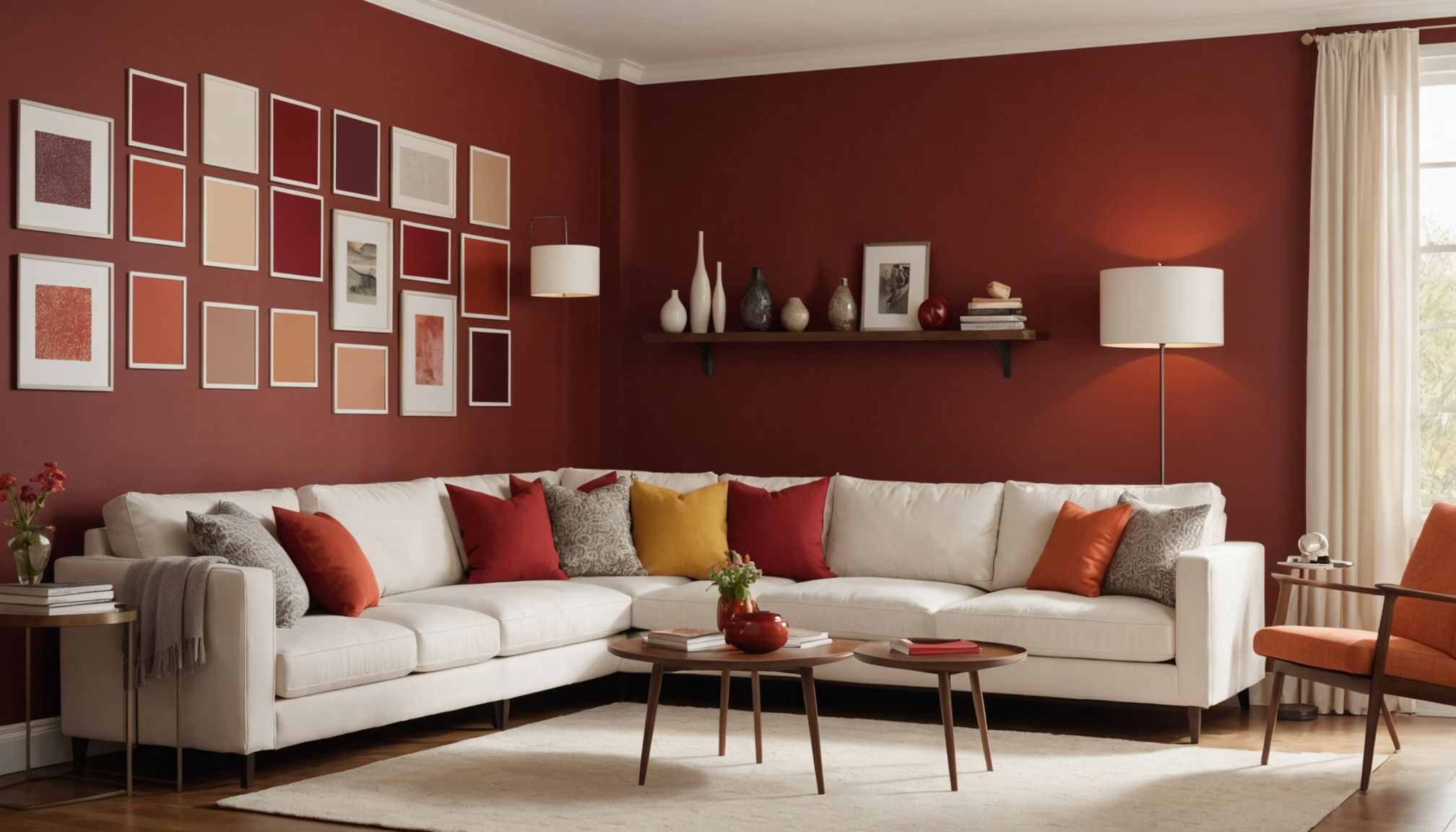Choosing the right color palette for your living room is not just an aesthetic decision; it’s a strategic investment in the feel and functionality of your space. Whether you’re looking to create a serene oasis or a vibrant social hub, the shades you select will significantly influence the overall ambiance and usage of the room. Additionally, the right color choices can enhance the perceived value of your home, a crucial consideration for those mindful of real estate trends.
Before you dive into the paint swatches, spend time analyzing the natural light that enters your room. South-facing rooms will have warm lighting, which works beautifully with cooler tones like blues and greens. Conversely, northern exposure tends to cast a cooler light, making it ideal for warmer hues such as reds and yellows that can add coziness and warmth. Remember to test color samples during different times of the day, since varying daylight can alter the appearance of a hue.
Your room’s dimensions should also inform your palette choice. Light shades such as soft whites and pastels can make a small space appear larger, while darker tones can add intimacy to larger spaces. Keep in mind the furniture and decor you already own, aiming for complementary or harmonious colors that will integrate well with existing items.
To create a cohesive look with adjacent rooms—especially if your living room is an open space connecting to the kitchen or bathroom—consider using a color palette consistent throughout these spaces. This can be achieved by choosing a base neutral color that flows seamlessly from one room to another and then adding personality with accent walls or pieces in each individual space.
Here’s a straightforward comparison to help guide your color selection:
| Room Size | Recommended Color Palette | Lighting Condition |
| Small | Light pastels, whites, airy blues | Bright, reflective, opens up space |
| Medium | Soft, neutral tones | Flexible, works with most light conditions |
| Large | Deep shades, warm tones | Creates intimacy and warmth |
Remember that trends come and go, but personal style should always remain at the forefront of your decision-making process. If you favor timeless elegance, classic hues such as navy blue, soft greys, or creamy whites can offer longevity. For those daring to be bold, a feature wall in a bright shade can be an exciting way to express creativity while adding interest without overwhelming the senses.
Ultimately, the color palette you select for your living room will set the mood for countless memories made within its walls. Embrace the power of paint as a tool to not only transform physical space but to enhance emotional well-being and express individual style.
Essential tools and materials
 To successfully paint your living room and achieve a professional-looking finish, assembling the right tools and materials is essential. Here’s a comprehensive list to ensure you’re fully prepared and equipped for the task at hand:
To successfully paint your living room and achieve a professional-looking finish, assembling the right tools and materials is essential. Here’s a comprehensive list to ensure you’re fully prepared and equipped for the task at hand:
- Paint: First and foremost, select high-quality paint suited to your wall type and finish preference. Consider investing in a durable, washable paint if your living room sees a lot of activity. This is particularly important for maintaining a fresh look over time.
- Primer: Primer is crucial, especially if you’re painting over darker colors or dealing with new walls. It ensures better adhesion of paint, increases durability, and provides additional protection for the wall surface. It’s an investment that pays off by enhancing the final appearance and longevity of your paint job.
- Paintbrushes: Have a variety of paintbrushes on hand. Angled brushes are ideal for cutting in along edges and corners, while smaller brushes are useful for intricate details or trim work.
- Rollers and Roller Trays: Choose a roller size based on your wall area—larger rollers cover more space quickly, while smaller ones are easier to handle in confined spaces. Ensure the nap of the roller matches the texture of your walls—a shorter nap for smooth surfaces and a longer nap for textured walls.
- Painter’s Tape: Essential for protecting trim, adjacent walls, and ceilings, painter’s tape allows you to achieve crisp, clean lines and prevent accidental smudges or spills in unwanted areas.
- Drop Cloths: Protect your floors and furniture with canvas or plastic drop cloths. Canvas drop cloths are particularly effective because they absorb spills and are less slippery underfoot.
- Ladder: If your living room has high ceilings, a sturdy ladder will be necessary to reach corners and edges safely. Ensure it’s stable and the right height for your space.
- Paint Stirrer: A wooden or plastic paint stirrer is an often overlooked but crucial tool for mixing paint thoroughly to ensure uniform color and consistency.
- Mixer Attachment: For larger quantities of paint, an electric drill attachment mixer can save time and ensure that the paint is perfectly blended.
- Rags and Sponges: Keep plenty of rags and sponges handy for quick cleanup of spills and drips. They’re also great for cleaning surfaces before painting.
- Patching Compound and Putty Knife: Before painting, inspect the walls for any holes or cracks. A patching compound and putty knife will allow you to repair imperfections, ensuring a smooth and even surface.
- Sandpaper: Essential for smoothing patched areas or rough surfaces. Having different grits available can help refine the surface before applying primer and paint.
- Protective Wear: Gloves, goggles, and old clothing or a painting suit protect you from splashes and ensure comfort throughout the process.
Ensuring you have all these tools and materials before you begin painting your living room is a strategic real estate move that not only enhances the aesthetic appeal but also optimizes the functionality and maintenance of your living space. Proper preparation with these essentials makes the process smoother, more efficient, and results in a breathtaking transformation of your living room.
Preparing your walls for painting
 Before you start transforming your living room with a new coat of paint, it’s crucial to prepare your walls properly to achieve a smooth and lasting finish. This preparatory step is an integral part of the painting process and can significantly impact the quality of the final result.
Before you start transforming your living room with a new coat of paint, it’s crucial to prepare your walls properly to achieve a smooth and lasting finish. This preparatory step is an integral part of the painting process and can significantly impact the quality of the final result.
Begin by inspecting your walls closely. Look for cracks, holes, and imperfections that need to be addressed. Fill these with a high-quality patching compound, using a putty knife to ensure a smooth surface. Once the compound is dry, sand it down with fine-grit sandpaper to blend seamlessly with the rest of the wall. This step is essential for anyone hoping to achieve a professional look and is especially important if you’re planning to showcase your living room as part of a real estate investment.
Next, focus on cleaning the surfaces. Dust, dirt, and grease can affect how paint adheres to the wall, resulting in uneven textures and potential peeling. Use a mild detergent and water to wash the walls, particularly in areas that are prone to buildup, such as near doorways or if your living room connects to high-use rooms like the kitchen or bathroom. Follow up with a damp cloth to remove any soap residue, making sure the walls are completely dry before moving forward.
After cleaning, mask off any areas you won’t be painting. Use painter's tape to protect molding, trim, and adjoining walls. This will help you achieve sharp, clean lines and prevent unwanted splatters. Lay down drop cloths to cover floors and any furniture that can’t be moved out of the room.
If your walls have a glossy finish, lightly sand them to create a surface that paint can adhere to more successfully. For highly textured surfaces, using a liquid degreaser can also improve paint adhesion. Applying a primer is another crucial step, particularly if you are transitioning from a darker hue to a lighter color. Priming the walls ensures a uniform finish and enhances the vibrancy and durability of your paint job.
By following these meticulous preparation steps, not only do you set the stage for a stunning transformation, but you also make a smart investment in the longevity and quality of your living space’s redesign. Proper wall preparation is the backbone of any successful painting project, bridging the gap between vision and reality by ensuring the paint adheres well and looks impeccable for years to come.
Techniques for applying paint evenly
 To achieve a flawless and evenly painted surface in your living room, adopting the right techniques is crucial. First and foremost, ensure that your painting area is well-lit, allowing you to clearly see the coverage as you work. Good lighting helps identify any missed spots and maintains consistency in color application, preventing unpleasant surprises once the paint dries.
To achieve a flawless and evenly painted surface in your living room, adopting the right techniques is crucial. First and foremost, ensure that your painting area is well-lit, allowing you to clearly see the coverage as you work. Good lighting helps identify any missed spots and maintains consistency in color application, preventing unpleasant surprises once the paint dries.
Begin by ‘cutting in’—a term used to describe painting around the edges and corners of walls with a brush. It’s a strategic start to the process, creating a border that a roller might miss. Using a high-quality angled brush, apply paint in long, steady strokes along the edges where walls meet ceilings and baseboards. Keep a wet edge as you work to ensure uniformity and prevent visible lines.
With the edges neatly done, transition to the roller. Choose a roller with the appropriate nap for your wall’s surface texture. For smoother walls, a shorter nap works wonders, while textured surfaces may require a longer nap. Load the roller carefully, avoiding over-saturation, which can lead to drips and an uneven finish. Rollers should be evenly covered but not dripping with paint.
Apply the paint using a ‘W’ or ‘M’ motion. This technique distributes the paint effectively and helps blend each stroke into the next. Starting from the upper corner of a section, move the roller downward in a zigzag pattern, then fill in the gaps with horizontal strokes. This approach ensures that paint is spread evenly, avoiding streaks or overlaps. Also, maintain a consistent pressure on the roller to achieve a smooth finish.
The technique of layering thin coats rather than one thick one cannot be overstated. Multiple thin layers allow the paint to dry more swiftly and evenly, reducing the potential for visible brush strokes and drip marks. Letting each coat dry fully before applying the next is an essential investment in time that leads to a professional-looking outcome.
Remember to occasionally step back and assess your work. It’s important to view your progress from a distance to ensure the color saturation is uniform and that no spots have been missed.
Throughout the process, be mindful of the humidity and temperature in your living room, which can affect drying times and paint appearance. For optimal results, follow the manufacturer’s recommendations for the ideal conditions in which to paint.
By mastering these painting techniques, you’re not just changing the color of your walls but enhancing the ambiance of your living space, which can significantly boost its perceived value—a valuable aspect if you’re considering real estate investments in the future. Whether you’re tackling the project as a DIY enthusiast or with an eye on how it integrates with other spaces like the kitchen or bathroom, these methods ensure a high quality and aesthetically pleasing finish.
Cleaning up and maintaining your paint job
 Once your paint job is complete, the next crucial step is cleaning up efficiently and ensuring the longevity of your freshly painted living room. Begin by carefully removing painter’s tape while the paint is still slightly damp to prevent peeling. Doing this step slowly and at a 45-degree angle helps maintain the clean lines you worked so hard to create.
Once your paint job is complete, the next crucial step is cleaning up efficiently and ensuring the longevity of your freshly painted living room. Begin by carefully removing painter’s tape while the paint is still slightly damp to prevent peeling. Doing this step slowly and at a 45-degree angle helps maintain the clean lines you worked so hard to create.
Next, focus on cleaning your brushes and rollers, as these tools represent a valuable investment for future projects. Use warm, soapy water for water-based paints or the appropriate solvent for oil-based ones to thoroughly clean your brushes and rollers, ensuring they last longer and perform well in subsequent uses. For paint trays and other equipment, a similar cleaning process applies. Make sure all remnants of paint are thoroughly washed away to prevent hardening.
Take down drop cloths carefully to avoid stirring up dust or dried paint flakes, and store them for future use. Check for any paint splatters on floors or furniture and clean them promptly with a suitable remover, especially for oil-based paints, where a solvent might be necessary.
Maintaining the new look of your living room requires some attention and care. Regularly dust and clean the walls with a soft cloth or duster to keep them looking fresh. For any scuff marks or stains, a gentle, non-abrasive cleaner should suffice—apply it with a damp sponge, and always test a small, inconspicuous area first to ensure no damage or discoloration occurs.
In general, avoid placing furniture or hanging pictures on the walls until the paint has fully cured, usually about two weeks. This precaution allows the paint to harden properly without smudges or impressions.
Finally, make it a habit to keep a small amount of leftover paint sealed and stored. This will come in handy for any future touch-ups and maintaining the cohesion of your color scheme. Properly labeled containers will ensure you can match colors accurately if you decide to update other rooms like the kitchen or bathroom in complementary tones.
In summary, painting your living room can be a transformative venture that marries aesthetic appeal with increased real estate value. By choosing a suitable color palette, preparing your walls adequately, employing the right application techniques, and following through with meticulous clean-up and maintenance, you not only revitalize your living space but also set it apart as a valuable investment. Attention to these details ensures your refreshed space will continue to inspire comfort and beauty for years to come.

